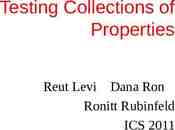Chapter 4 Types of Fire Alarm and Detection Systems
26 Slides1.19 MB

Chapter 4 Types of Fire Alarm and Detection Systems

Objectives List and discuss the different fire alarm system classifications. List and discuss the interface capabilities between fire alarm systems and other building fire protection and life safety systems.

Objectives List and discuss the different conditions, situations, and circumstances used to determine manual fire alarm and automatic detection system installation requirements. Describe the different acceptance and periodic inspections, tests, and maintenance activities required for fire alarm systems.

Introduction The type of fire alarm system installed in a particular building depends on many factors established by the model codes. Systems are classified according to the certain operational events that take place when the system activates. The party responsible for the activities associated with the alarm is determined by the type of system installed.

Classification of Fire Alarm Systems Overview – System classification is based on: Which operational events take place, and how Whether the system serves more than one purpose – NFPA 72, National Fire Alarm and Signaling Code, establishes: Two broad system classifications Five subcategories A. Maurice Jones, Jr./Jones & Bartlett Learning

Classification of Fire Alarm Systems Alarm systems – Fire alarm systems Single-station Multiple-station Combination systems Household fire alarm systems Protected premises fire alarm system A. Maurice Jones, Jr./Jones & Bartlett Learning

Classification of Fire Alarm Systems Alarm systems – Supervising station alarm systems Central station Remote supervising station Proprietary supervising – Public emergency alarm reporting systems Local energy Shunt auxiliary Jones & Bartlett Learning

Classification of Fire Alarm Systems Emergency communication systems – One-way emergency communication systems EVACS In-building mass notification Wide area mass notification – Two-way emergency communication systems Permit first responders/building occupants the opportunity to communicate between locations A. Maurice Jones, Jr./Jones & Bartlett Learning

Interface with Other Systems A fire alarm system can: – – – – Unlock exit doors Close doors Recall/shut down elevators Turn on/shut down air handling equipment – Start up smoke control equipment – Close fire dampers A. Maurice Jones, Jr./Jones & Bartlett Learning – Monitor and activate fire suppression systems

Required Installations Overview – NFPA or ICC model codes Use and occupancy Number of occupants Levels above or below exit discharge Types of products used or manufactured Whether other fire protection systems will be installed

Required Installations Use-group and occupancy – Installing a fire system can be especially important when a building is large or has a large number of occupants. – Factors and considerations specific to the use or occupancy Occupant load Occupant capability Building height Number of levels above or below exit discharge

Required Installations Number of occupants – The number of individuals and their location in the structure are important factors. – There are differences in the occupant threshold limit between the NFPA model codes and the ICC’s IBC for businesses. – The occupancy load does not factor into requirements for automatic smoke detection in assembly or business occupancies.

Required Installations Building height – Dependent on the number of levels above or below exit discharge – Neither of the model codes determines requirements for smoke detection based on building height.

Required Installations Level of exit discharge – The number of occupants who are above or below the discharge level will determine if a manual fire alarm is required. – Neither of the model codes requires automatic smoke detection installation purely based on the level of exit discharge.

Required Installations Manufacturing and use products – Both model codes require manual fire alarm systems in semiconductor manufacturing facilities. – Requirements for automatic detection systems Highly toxic gases Organic peroxides Oxidizers stored or used exceeding the maximum permitted amount

Required Installations Special use and occupancy conditions – IBC requires a manual fire alarm system in deep underground buildings. – IBC requires automatic fire detection in certain areas of any building classified as a high-rise building. Office building Hotel Apartment Condominium

Required Installations Installation of other fire protection systems – In some occupancies, automatic sprinkler systems permit the exclusion of manual fire alarm boxes. – Automatic system installations permit omission of smoke detectors in a few situations.

Design and Installation Standards NFPA 72 – Provides application, design, installation, inspection, testing, and maintenance requirements – Has information concerning components, hardware, system types, power requirements, etc. – Establishes minimum requirements for installation – References other standards to deal with specific issues relating to the installation of fire alarm and detection systems

Fire Alarm System Inspection and Testing Overview – Operational integrity Initial acceptance test Lifetime of periodic inspections and tests

Fire Alarm System Inspection and Testing Acceptance test – Sound design – Thorough plan review – Solid documentation – Proper installation – Inspection oversight throughout – Final acceptance test A. Maurice Jones, Jr./Jones & Bartlett Learning

Fire Alarm System Inspection and Testing Periodic inspection, testing, service, and maintenance – False alarms Lack of or improper inspection, testing, service, and maintenance – NFPA 72 Detailed inspection Test intervals

Summary NFPA 72 classifies fire alarm systems based on the operational events of the system and how signal monitoring and reporting take place in the system. Some systems rely on a person to initiate an alarm and notify the fire department. Other systems automatically activate and report to an on-site location for investigation by staff. The most sophisticated systems automatically activate and report the exact location and type of device to on- and off-site personnel.

Summary Installation requirements for fire alarm and detection systems depend on the use and occupancy conditions, factors, and considerations, including occupant load, occupant capability, and the building height or number of levels above or below exit discharge.

Summary Additional requirements for fire alarm and/or detection system installation are determined by special use and occupancy conditions, the manufacturing of certain products, and the installation of other fire protection systems.

Summary NFPA 72, National Fire Alarm and Signaling Code, has been and continues to be the standard for fire alarm and detection system design, installation, inspection, testing, and service. However, as comprehensive as NFPA 72 is, reference to other standards is needed to properly design and install fire alarm and detection systems.

Summary The fire alarm system acceptance test establishes the minimum system installation and operation characteristics. Periodic inspection, testing, service, and maintenance ensure system reliability.






